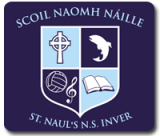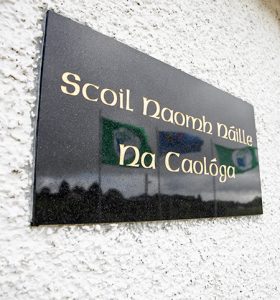We are very proud of our Green School Status here at St. Naul’s National School, and have now achieved four Green Flags:
- Litter & Waste
- Energy
- Water
- Travel
The Green Schools’ Committee is very pleased to announce that we are busily working on the fifth theme of the Green Schools Project, which is Biodiversity
What is Biodiversity? You may ask!
The meaning of ‘Biodiversity’ is easy to understand when we break the word down; “bio” refers to life and ‘living things’ and “diversity” means just that; range or variety. The word refers to the huge variety and variation of life that surrounds us on planet earth. Maintaining a high level of diversity among plants, animals and all living things all around us is essential in keeping the environment healthy and fit for human life. This includes diversity within species, between species and diversity of ecosystems.
We interact with and have an impact on living things, directly and indirectly every day through our lifestyles; e.g. the food we eat or how we manage our gardens. So whether our school is based in a city or in the country like St. Naul’s National School the Biodiversity theme hopes to connect you, our school and our wider community with the natural environment and cultivate a sense of wonder, appreciation and value for all the biodiversity around us.
The overall aim of the Biodiversity theme is for schools to increase awareness of the importance of biodiversity and for students and staff to come up with ways to help biodiversity.
Some Important Biodiversity Terms:
• Species: A species is a group of organisms capable of interbreeding and producing fertile offspring. For example, the Mountain Ash is a species of tree, and the Red Squirrel is a species of mammal, the Chaffinch is a species of bird.
• Native Species: Our native species are the species of plants and animals that reached Ireland naturally; mostly since the last ice-age before Ireland was separated from the rest of Europe by the rising sea. As an example, the most common native trees in Ireland include oak, ash, hazel, birch, Scots pine, rowan and willow. Eventually, people brought other plants on their travels many years later. Native plant species are the preferred species for planting in school and home gardens.
• Non-Native, ‘Alien’ & Invasive Species: Alien species are also known as ‘non-native’ species. These are plants and animals that would not be found in Ireland without human involvement. Not all alien species in Ireland are able to survive and establish in the wild. Of those that do establish some can impact on our biodiversity and become invasive. The ability of a species to become invasive depends on a number of factors. These can include biological traits such as fast growth and reproduction. Invasive species often spread quickly or can move easily from place to place.
• Habitat: A habitat is the natural environment in which an organism lives, or the physical environment that surrounds, influences and is utilised by a species population. For example, a Red Squirrel lives in a Woodland habitat, and a Humpback Whale lives in a Marine habitat.
• Ecosystem: An Ecosystem is a community of plants, animals, fungi and micro-organisms that live, feed, reproduce and interact together in the same area or environment. Irish examples include a Bog, Woodland, a Marsh, a Hedge, a Lake, an Ocean or even a Rock Pool. You may also hear about Ecosystem Services. These are the benefits that ecosystems can provide to us, e.g. woodlands provide protection from flooding; forests can regulate climate change; reed-beds can break down wastes and recycle nutrients and can filter and purify water; animals and microbes working in soil maintain and increase soil fertility; plants purify the air; some animals and plants control pests and diseases and provide goods such as woods, textiles and food.
Each Green School Project is based around Seven Steps:
Step 1 – Green School Committee. Our committee is up and running and busily working on our project!
Step 2 – Environmental Review. This was done by creating a habitat map of our school to get a starting point for our project. We also carried out awareness surveys with students of the school.
Step 3 – Action Plan – this states what our targets are and how we are going to achieve them.
Step 4 – Monitoring and Evaluation – means we will be measuring the success of our Biodiversity Action Plan. We will be repeating the awareness surveys during the course of the project to see how we are getting on.
Step 5 – Curriculum work. We are always learning at school about the habitat we live in. This project will give us a chance to show our work to the green schools inspector.
Step 6 – Informing and Involving. This step will be our chance to inform the parents and wider community about the work we have been doing. We will be keeping our website up to date with all our work and we will be hoping that parents and families will become involved by perhaps carrying out some changes to their home habitats.
Step 7 – Green School Code. We always have great fun with this step! We hold an art competition to design a character and motto to represent our project! We have had ‘Barry the Binman’, ‘Sonic The Switch’, ‘Danny the Drain’ and ‘Gary the Grape’ to name but a few!
Biodiversity in Ireland
• Ireland is home to about 815 flowering plants, about 80 native ferns, more than 700 mosses and liverworts, 3,500 fungi, over 1,000 lichens and 1,400 algae. There are 32 terrestrial mammals, ten bat species, two species of seals and about 24 whales and dolphins. About 425 species of birds have been recorded in Ireland, about half of these birds breed here.
• Many of these species are already under threat, some are even endangered. The freshwater pearl mussel, which lives in Irish rivers and is Ireland’s longest living animal, is facing extinction. If we want all of these species to survive, we must ensure that there are enough suitable areas for all to flourish.
• Ireland also has an extensive coastline rich in biodiversity and so we should not forget our surrounding seas. There is a huge array of life in our seas, most of which we may never see. Unfortunately, this too is being negatively affected in a variety of ways: overfishing, coastal activities and pollution are some examples, and so it is important that our marine habitats are also protected.
• The National Parks & Wildlife Service (NPWS) looks after the conservation of much of Ireland’s habitats and species. Ireland has six National Parks: Glenveagh, Co. Donegal, Ballycroy, Co. Mayo, Connemara, Co. Galway, the Burren, Co. Clare, the Wicklow Mts. and Killarney, Co. Kerry.
We are enjoying working on our Green School Project and hope to achieve our fifth Green Flag for our school!

